1990 VOLKSWAGEN TRANSPORTER Changing a wheel
[x] Cancel search: Changing a wheelPage 4 of 165

Downloaded from www.Manualslib.com manuals search engine
1
INSTRUMENT PANEL
Illustration instruments and controls
Warning and indicator light symbols
CONTROLS AND EQUIPMENT
Keys,
central locking system .... 7, 8
Doors 9
Rear lid 11
Windows, mirrors 12, 13 Safety belts, head restraints . . . .14,19
Seats 20 Luggage compartment, pedals . 28,29
Brakes, Transmission 29, 32 Differential lock 33
Automatic-transmission 35 Steering lock/ignition/starter switch . 38
Starting procedures 39 Instrument cluster 40
Warning/indicator lights 43 Switches 46 Emergency flasher 46
Light switch, turn signals .... 46,48
Cruise control 49
Windshield wipers 50 Ventilation/Heating 51
Air conditioning 54
Heater 57
Sliding roof 62
Roof-rack 68 VEHICLE OPERATION
Break-in period - and afterwards . . 69
Operate your vehicle safety 70
Operate your vehicle economically
and minimize pollution 72
Trailer towing 73 Driving with the all-wheel drive ... 75
VEHICLE CARE
Fuel tank, fuel supply 85,86
Vehicle care (exterior/interior) . . 90, 93 Maintenance, inspection intervals . . 95 Engine compartment lid,
engine compartment 97 Lubricants, engine oil 98,99
Engine oil filter 101
Transmission oil 102
Power steering 103
Cooling system 104 Brake fluid 108
Battery 109
Windshield washers/wipers . . . 112,113
Tires/wheels 114 Difficult operating conditions .... 120
Winter driving 121
Accessories 122
DO-IT-YOURSELF SERVICE
Jack and tools 123 Spare wheel 124
Changing a wheel 125 Fuses, bulbs 128, 130 Adjusting headlights
134
Installing,
replacing the radio . . . . 135
Emergency starting 136
Emergency towing 138
Lifting vehicle . . 140
TECHNICAL DESCRIPTION
Engine, transmission 142
Steering,
suspension, brakes,
body, chassis 143 Emission-control-system 144
TECHNICAL DATA
Engine, spark plugs .
V-belts capacities . . Dimensions
Weights
Vehicle identification 146
147
148
150 151
CONSUMER INFORMATION
Service manuals 152
GAS STATION INFORMATION
Location of servicing points 156
ALPHABETICAL INDEX 158
www.westfaliaT3.info - a useful website for owners and enthusiasts of VW Westfalia T25 / T3 Campervans
Page 75 of 165
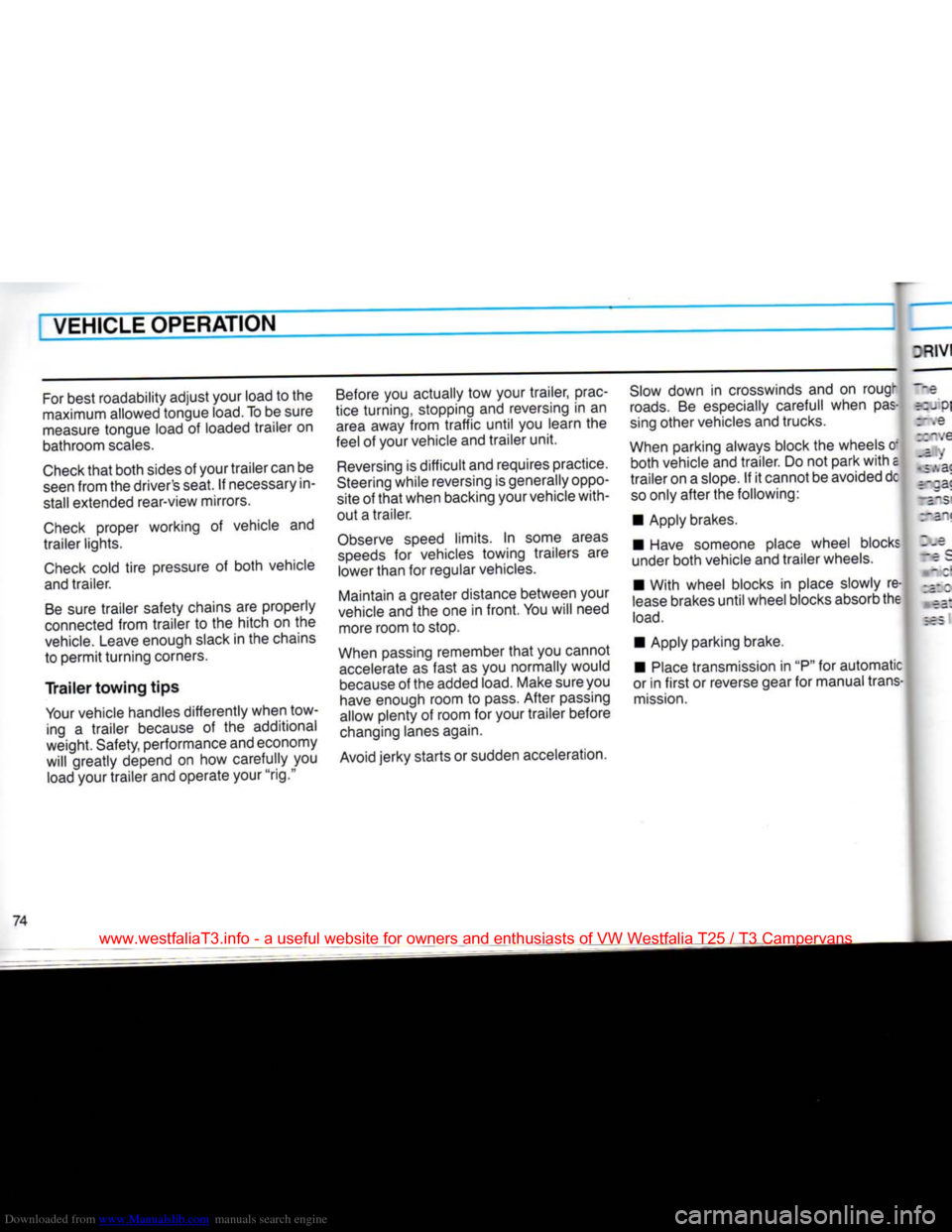
Downloaded from www.Manualslib.com manuals search engine
VEHICLE OPERATION
For
best roadability adjust your load to the
maximum allowed tongue load. To be sure
measure
tongue load of loaded trailer on
bathroom
scales.
Check
that
both sides of your trailer can be
seen
from the driver's seat. If necessary in
stall extended rear-view mirrors.
Check
proper working of vehicle and
trailer lights.
Check
cold
tire
pressure of both vehicle
and
trailer.
Be
sure trailer safety chains are properly
connected
from trailer to the hitch on the
vehicle.
Leave enough slack in the chains
to permit turning corners.
Trailer
towing
tips
Your
vehicle handles differently when tow ing a trailer because of the additional
weight. Safety, performance and economy
will greatly depend on how carefully you
load
your trailer and operate your "rig."
Before
you actually tow your trailer, prac
tice turning, stopping and reversing in an
area
away from
traffic
until
you learn the
feel of your vehicle and trailer
unit.
Reversing
is
difficult
and requires practice.
Steering
while reversing is generally oppo
site of
that
when backing your vehicle with
out a trailer.
Observe
speed limits. In some areas
speeds
for vehicles towing trailers are lower than for regular vehicles.
Maintain a greater distance between your
vehicle
and the one in
front.
You will need more room to stop.
When
passing remember
that
you cannot
accelerate
as fast as you normally would
because
of the added load. Make sure you
have
enough room to
pass.
After passing
allow plenty of room for your trailer before
changing
lanes again.
Avoid
jerky starts or sudden acceleration.
Slow
down in crosswinds and on rougi"
roads.
Be especially carefull when
pas
sing
other vehicles and trucks.
When
parking always block the wheels o: both vehicle and trailer. Do not park
with
a
trailer on a slope. If it cannot be avoided dc
so
only after the following:
• Apply brakes.
• Have someone place wheel blocks
under both vehicle and trailer wheels.
• With wheel blocks in place slowly re
lease
brakes
until
wheel blocks absorb the
load.
• Apply parking brake.
•
Place
transmission in
"P"
for automatic
or in
first
or reverse gear for manual trans
mission.
74
www.westfaliaT3.info - a useful website for owners and enthusiasts of VW Westfalia T25 / T3 Campervans
Page 77 of 165
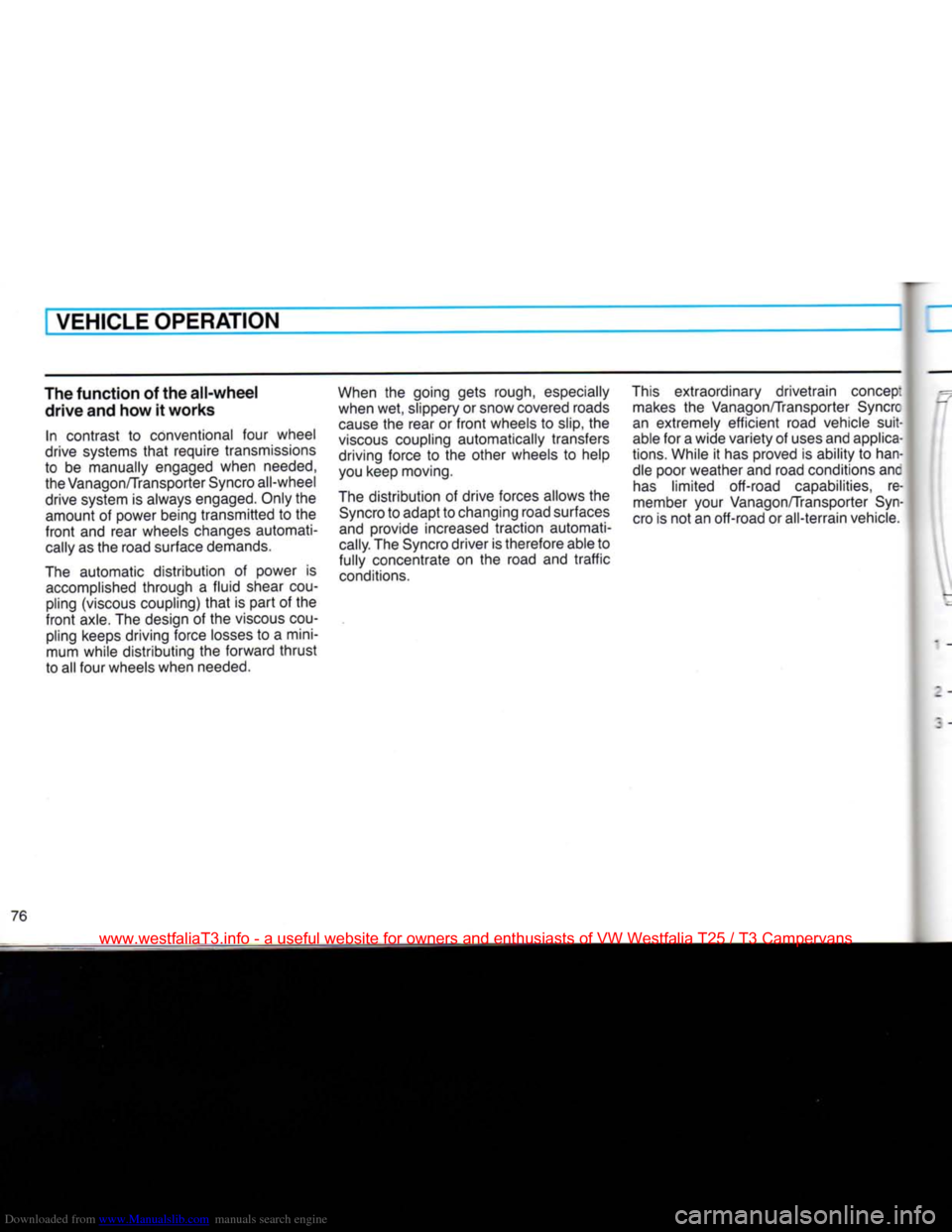
Downloaded from www.Manualslib.com manuals search engine
VEHICLE
OPERATION
The
function
of the
all-wheel
drive
and how it
works
In contrast to conventional four wheel
drive systems
that
require transmissions
to be manually engaged when needed,
the Vanagon/Transporter Syncro all-wheel
drive system is always engaged. Only the
amount of power being transmitted to the
front
and rear wheels changes automati
cally
as the road surface demands.
The automatic distribution of power is
accomplished
through a
fluid
shear
cou
pling (viscous coupling)
that
is
part
of the
front
axle. The design of the viscous
cou
pling keeps driving force losses to a mini
mum while distributing the forward
thrust
to all four wheels when needed. When the going gets rough, especially
when wet, slippery or snow covered roads
cause
the rear or
front
wheels to slip, the
viscous
coupling automatically transfers driving force to the other wheels to help
you keep moving.
The distribution of drive forces allows the
Syncro
to adapt to changing road surfaces
and provide increased traction automati
cally.
The Syncro driver is therefore able to
fully
concentrate on the road and
traffic
conditions.
This
extraordinary drivetrain concep:
makes
the Vanagon/Transporter Syncrc
an extremely efficient road vehicle suit
able for a wide variety of uses and applica
tions. While it has proved is ability to han
dle poor weather and road conditions anc
has
limited off-road capabilities, re
member your Vanagon/Transporter
Syn
cro is not an off-road or all-terrain vehicle.
76
www.westfaliaT3.info - a useful website for owners and enthusiasts of VW Westfalia T25 / T3 Campervans
Page 120 of 165
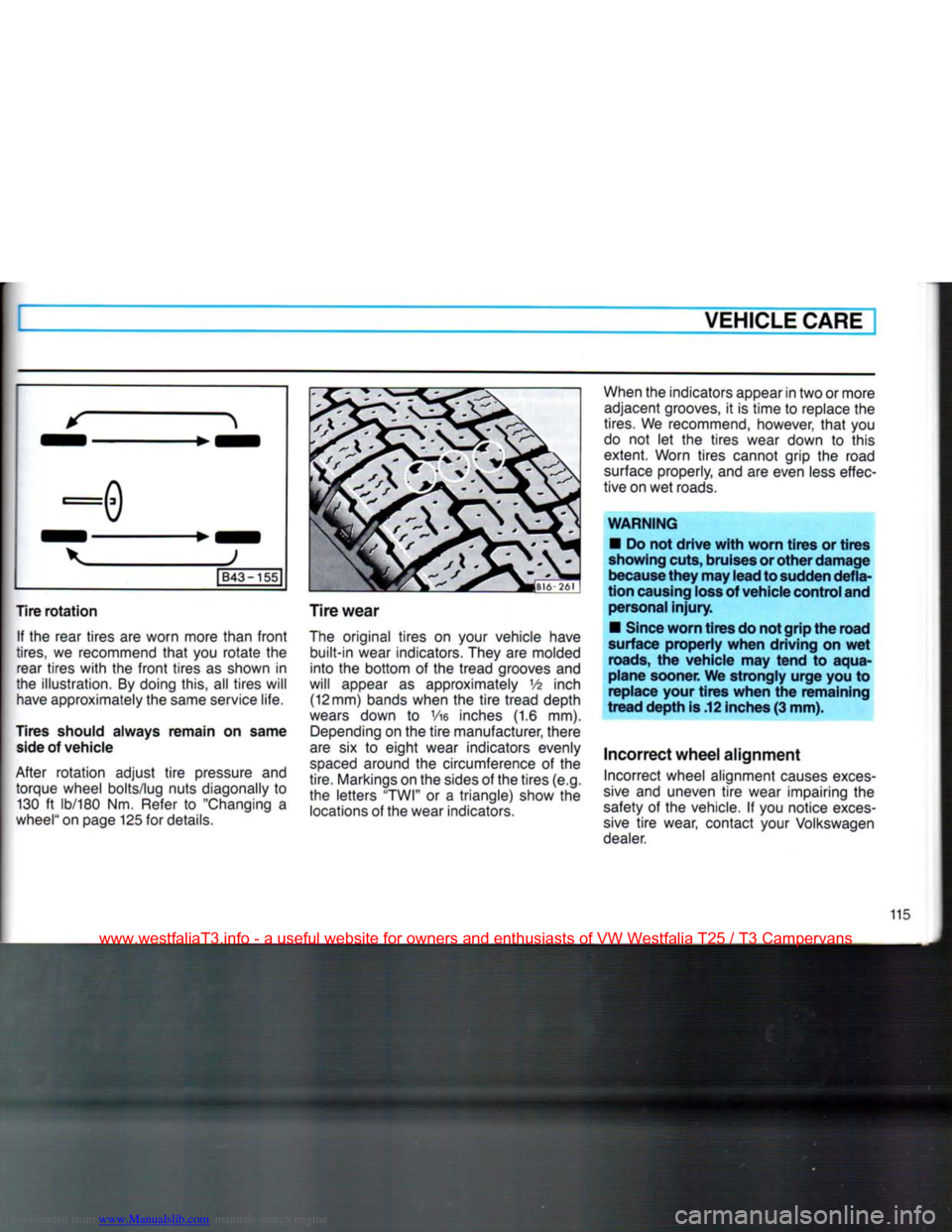
Downloaded from www.Manualslib.com manuals search engine
VEHICLE CARE
K >i
|B43-155|
Tire rotation If the
rear tires
are
worn more than
front
tires,
we
recommend
that
you
rotate
the
rear tires
with
the
front
tires
as
shown
in
the illustration.
By
doing this,
all
tires will
have
approximately the same service life.
Tires
should always remain on same
side
of vehicle
After rotation adjust
tire
pressure
and
torque wheel bolts/lug nuts diagonally
to
130
ft
lb/180
Nm.
Refer
to
"Changing
a
wheel"
on page 125
for
details.
Tire
wear
The
original tires
on
your vehicle have
built-in wear indicators. They
are
molded
into
the
bottom
of the
tread grooves
and
will appear
as
approximately
V6
inch (12 mm) bands when
the
tire
tread depth
wears
down
to Vie
inches
(1.6 mm).
Depending
on the
tire
manufacturer, there
are
six to
eight wear indicators evenly
spaced
around
the
circumference
of the
tire. Markings on the sides
of
the tires (e.g.
the letters "TWI"
or a
triangle) show
the
locations
of
the wear indicators.
When
the indicators appear in two
or
more
adjacent grooves,
it is
time
to
replace
the
tires.
We
recommend, however,
that
you
do
not let the
tires wear down
to
this
extent. Worn tires cannot grip
the
road
surface
properly, and are even
less
effec
tive on wet roads.
WARNING
•
Do not drive
with
worn tires or tires
showing
cuts,
bruises
or other damage
because
they may lead to
sudden
defla
tion
causing
loss
of
vehicle
control
and
personal
injury.
•
Since
worn tires do not grip the road
surface
properly when driving on wet
roads,
the vehicle may tend to aqua
plane sooner. We strongly urge you to
replace your tires when the remaining
tread depth is .12
inches
(3 mm).
Incorrect
wheel
alignment
Incorrect wheel alignment
causes
exces
sive
and
uneven
tire
wear impairing
the
safety
of the
vehicle.
If
you notice
exces
sive
tire
wear, contact your Volkswagen
dealer.
115
www.westfaliaT3.info - a useful website for owners and enthusiasts of VW Westfalia T25 / T3 Campervans
Page 122 of 165
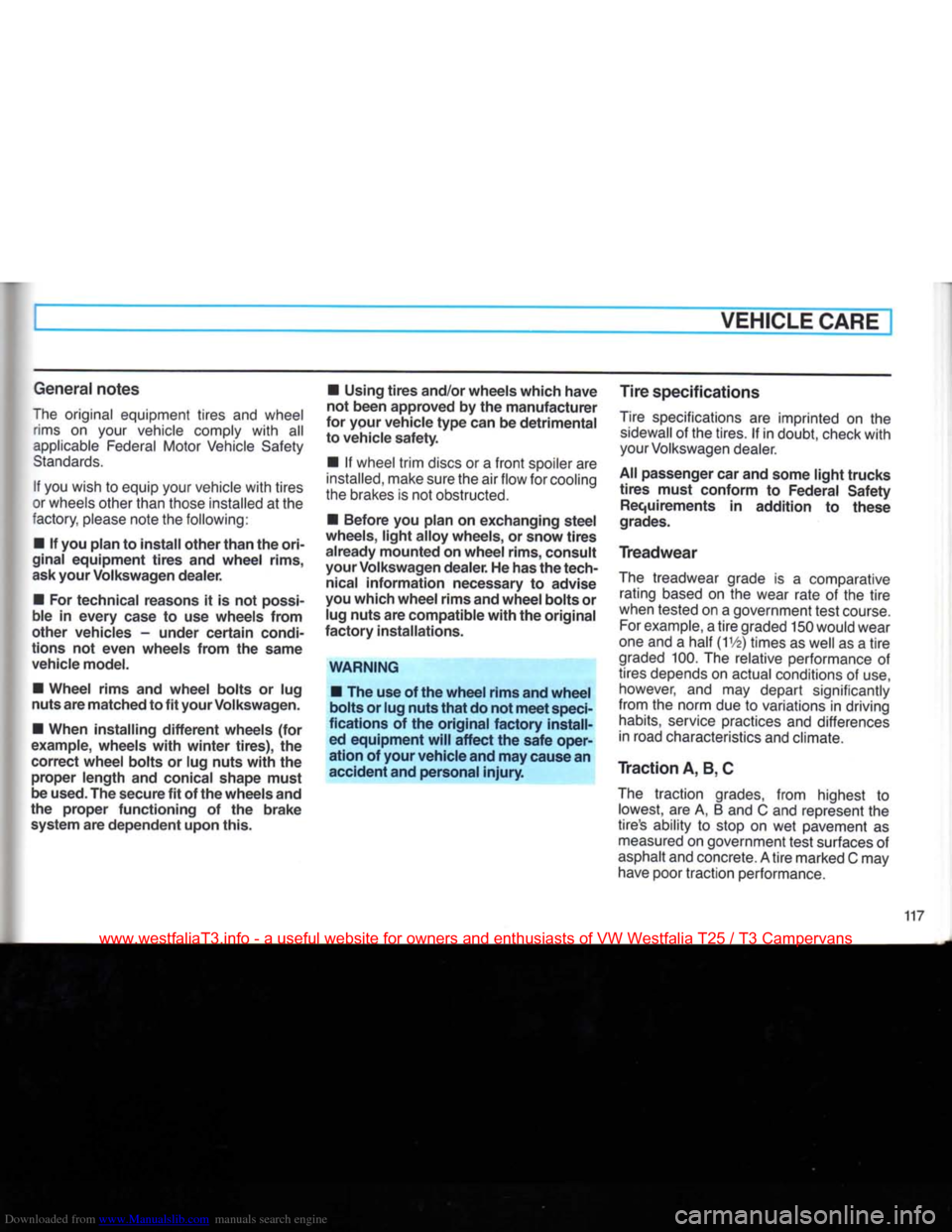
Downloaded from www.Manualslib.com manuals search engine
VEHICLE
CARE
General notes
The original equipment tires
and
wheel
rims
on
your
vehicle comply with
all
applicable
Federal Motor Vehicle Safety
Standards.
If you
wish
to
equip
your
vehicle with tires
or wheels other than those installed
at the
factory, please note
the
following:
•
If
you plan
to
install other than the
ori
ginal
equipment tires
and
wheel rims,
ask
your
Volkswagen dealer.
•
For
technical reasons
it is not
possi
ble
in
every
case
to use
wheels from
other vehicles
-
under certain condi
tions
not
even wheels from
the
same
vehicle
model.
•
Wheel rims
and
wheel bolts
or lug
nuts are matched to fit
your
Volkswagen.
•
When installing different wheels
(for
example,
wheels with winter tires),
the
correct wheel bolts
or
lug nuts with
the
proper length
and
conical shape must
be used. The secure fit of the wheels and
the proper functioning
of the
brake system are dependent upon this.
•
Using tires and/or wheels which have
not been approved
by
the manufacturer
for
your
vehicle
type
can be detrimental
to vehicle safety.
•
If
wheel trim discs
or a
front
spoiler
are
installed,
make
sure the airflow for cooling
the brakes
is not
obstructed.
•
Before
you
plan
on
exchanging steel
wheels, light alloy wheels,
or
snow tires
already mounted on wheel rims, consult
your
Volkswagen dealer. He has the tech
nical
information necessary
to
advise
you which wheel rims and wheel bolts
or
lug
nuts are compatible with the original
factory installations.
WARNING
•
The
use of the wheel rims and wheel
bolts
or
lug nuts that do not meet
speci
fications
of the
original factory
install
ed equipment will affect the safe oper
ation
of
your
vehicle and may cause an
accident and personal
injury.
Tire specifications
Tire
specifications
are
imprinted
on the
sidewall
of
the tires.
If in
doubt, check with
your
Volkswagen dealer.
All
passenger car and some light trucks tires must conform
to
Federal Safety
Requirements
in
addition
to
these
grades.
Treadwear
The treadwear grade
is a
comparative
rating
based
on the
wear rate
of the
tire
when tested
on a
government test course. For example,
a
tire graded
150
would wear
one
and a
half
(IV2)
times
as
well
as a
tire
graded 100.
The
relative performance
of
tires depends
on
actual conditions
of use,
however,
and may
depart significantly
from
the
norm
due to
variations
in
driving
habits,
service practices
and
differences
in road characteristics and
climate.
Traction A, B, C
The traction grades, from highest
to
lowest,
are A, B and C and
represent
the
tire's ability
to
stop
on wet
pavement
as
measured
on
government test surfaces
of
asphalt
and concrete. Atire marked
C
may
have poor traction performance.
www.westfaliaT3.info - a useful website for owners and enthusiasts of VW Westfalia T25 / T3 Campervans
Page 128 of 165
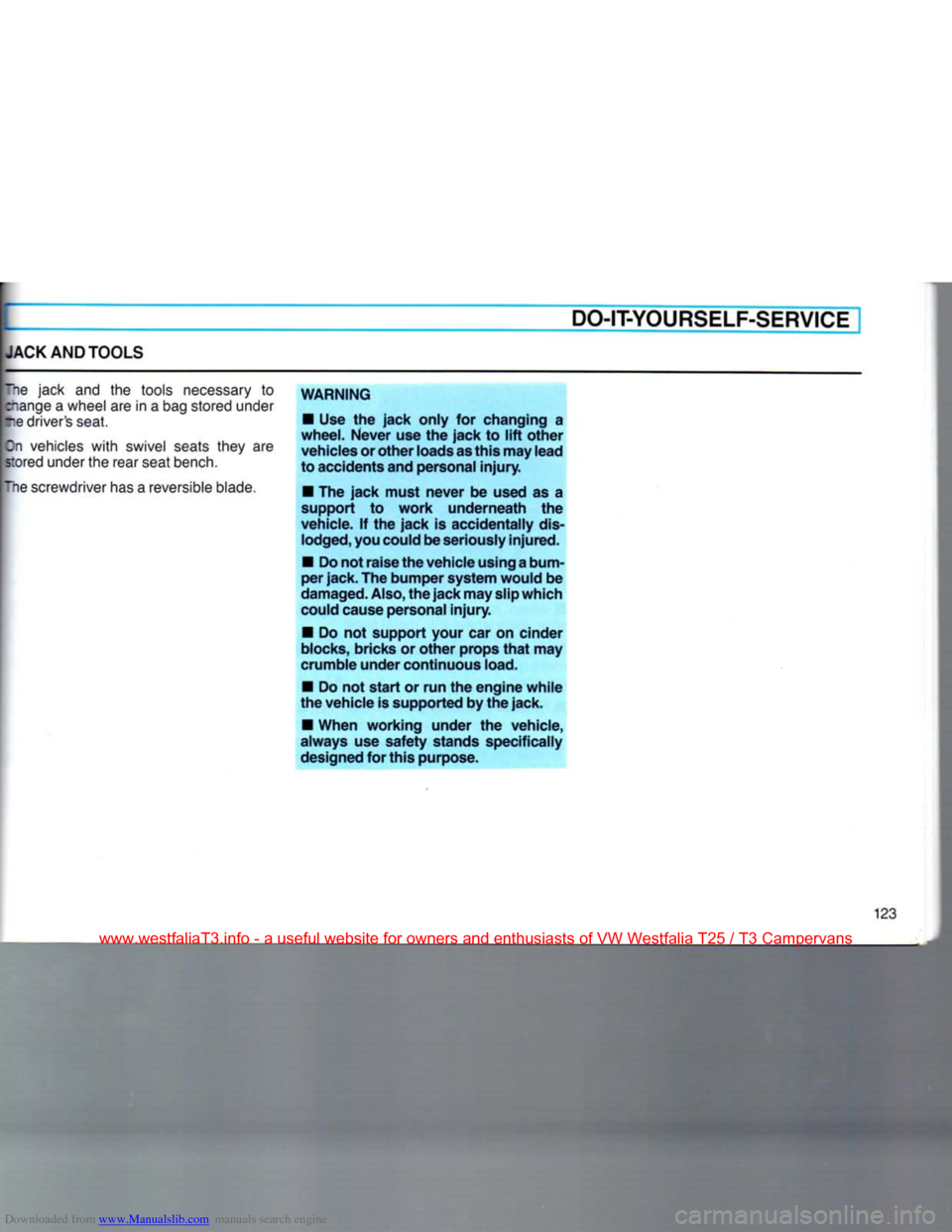
Downloaded from www.Manualslib.com manuals search engine JACK AND
TOOLS
DO-IT-YOURSELF-SERVICE
The jack and the tools necessary to
Bange
a wheel are in a bag stored under
re driver's seat.
Zn vehicles
with
swivel seats they are
stored under the rear seat bench.
~ne
screwdriver has a reversible blade.
WARNING
• Use
the
jack only
for
changing
a
wheel.
Never
use the jack
to
lift other vehicles or other loads
as
this may lead
to accidents and personal
injury.
• The jack must
never
be
used
as a
support
to
work underneath
the
vehicle.
If
the jack
is
accidentally dis lodged, you could be seriously injured.
• Do not
raise
the vehicle using
a
bum
per
jack.
The bumper system would be
damaged.
Also, the jack may
slip
which
could cause personal
injury.
•
Do not
support
your
car on cinder
blocks,
bricks or other props that may
crumble under continuous
load.
• Do not start
or
run the engine while
the vehicle is supported by the jack.
• When working under
the
vehicle,
always
use
safety stands specifically
designed for this purpose.
123
www.westfaliaT3.info - a useful website for owners and enthusiasts of VW Westfalia T25 / T3 Campervans
Page 131 of 165
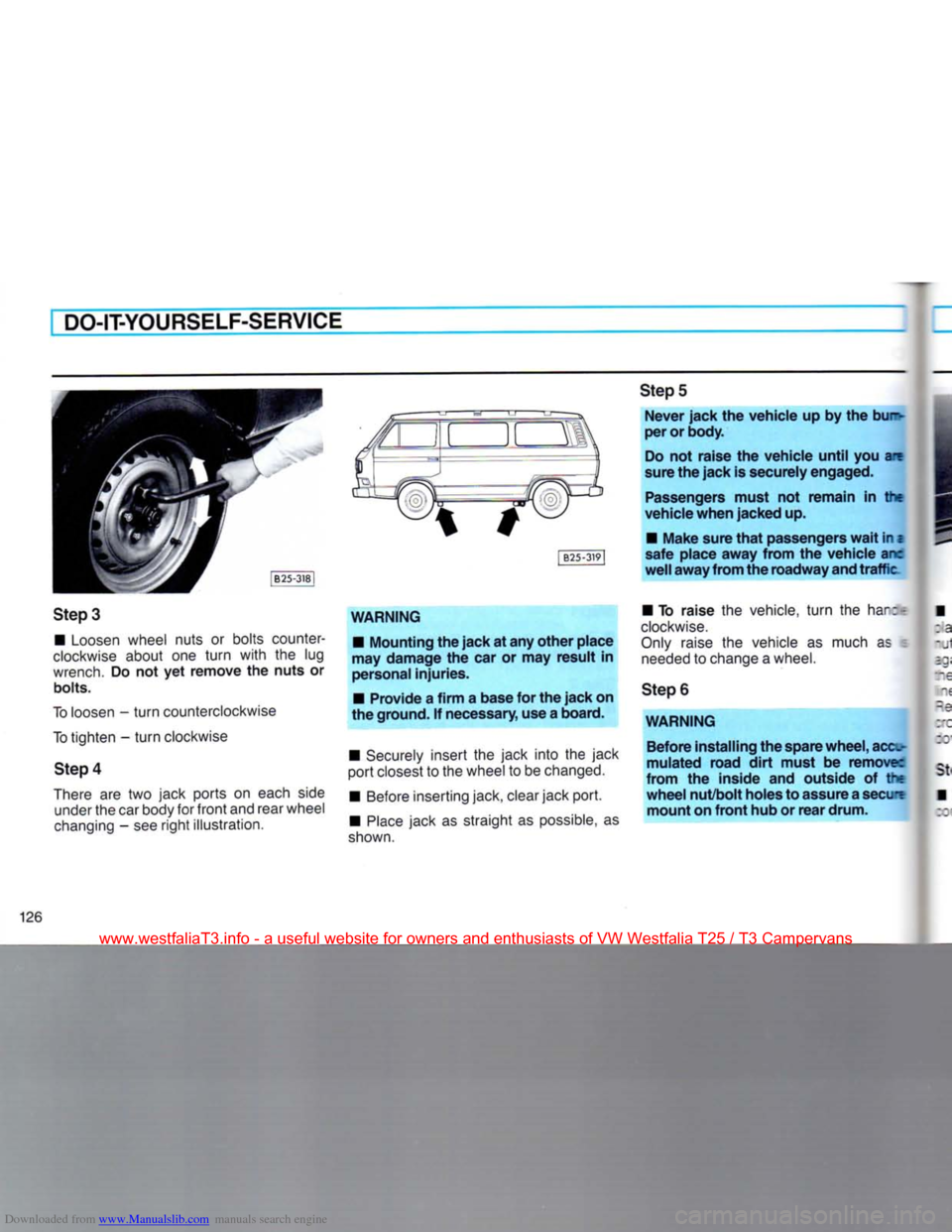
Downloaded from www.Manualslib.com manuals search engine
DO-IT-YOURSELF-SERVICE
Step
3
•
Loosen
wheel
nuts or bolts counter
clockwise
about one turn with the lug
wrench.
Do not yet remove the nuts or
bolts.
To
loosen
- turn
counterclockwise
To
tighten - turn
clockwise
Step
4
There
are two jack ports on
each
side
under
the car
body
for front and
rear
wheel
changing
- see right illustration. [
B25-3)9|
WARNING
•
Mounting the jack at any other place
may damage the car or may result in
personal
injuries.
•
Provide a firm a base for the jack on
the ground. If
necessary,
use a board.
•
Securely
insert the jack into the jack
port
closest
to the
wheel
to be
changed.
•
Before
inserting jack,
clear
jack port.
•
Place
jack as straight as
possible,
as
shown.
Step
5
Never jack the vehicle up by the bu~
per or body.
Do
not raise the vehicle until you are
sure
the jack is securely engaged.
Passengers
must not remain in the
vehicle when jacked up.
•
Make sure
that
passengers
wait
in z
safe place away from the vehicle arc
well
away from the roadway and traffic
•
To raise the
vehicle,
turn the
har:T
clockwise.
Only
raise
the
vehicle
as
much
as
needed
to
change
a
wheel.
Step
6
WARNING Before installing the spare wheel, acc-
mulated road
dirt
must be remove:
from the inside and outside of the
wheel nut/bolt holes to assure a secure mount on front hub or rear drum.
126
www.westfaliaT3.info - a useful website for owners and enthusiasts of VW Westfalia T25 / T3 Campervans
Page 145 of 165
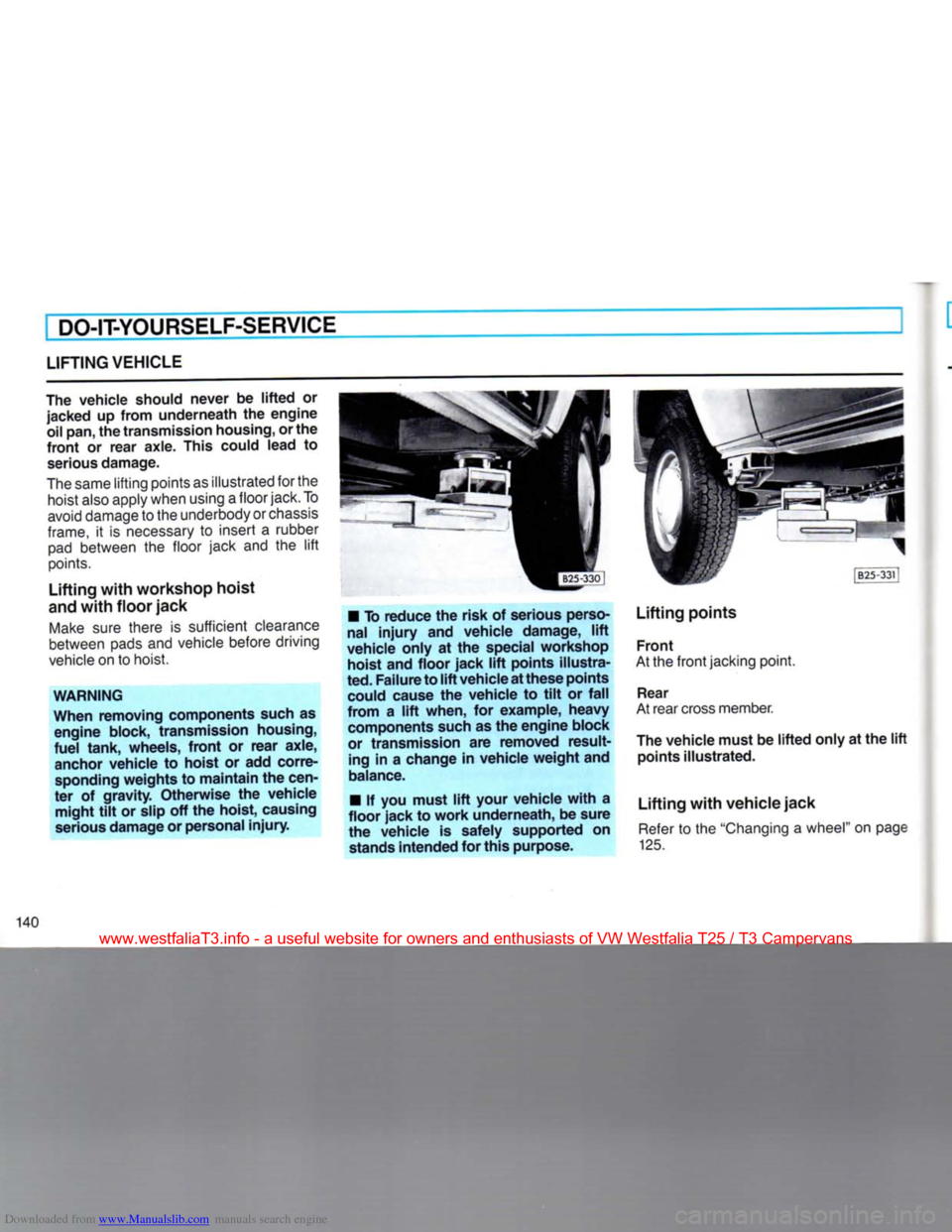
Downloaded from www.Manualslib.com manuals search engine
DO-IT-YOURSELF-SERVICE
LIFTING
VEHICLE
The vehicle should
never
be lifted or
jacked
up from underneath the engine
oil
pan, the transmission housing, or the
front
or rear axle.
This
could lead to serious damage.
The same lifting points as illustrated for the hoist also apply when using a floor jack. To
avoid damage to the underbody or chassis
frame,
it is necessary to insert a rubber pad between the floor jack and the lift
points.
Lifting
with workshop hoist
and with floor jack
Make
sure there is sufficient clearance
between pads and vehicle before driving
vehicle on to hoist.
WARNING
When removing components such as engine block, transmission housing,
fuel
tank, wheels,
front
or rear axle, anchor vehicle to hoist or add corre
sponding weights to maintain the cen
ter of
gravity.
Otherwise the vehicle
might tilt or slip off the hoist, causing
serious damage or personal
injury.
•
To reduce the risk of serious perso
nal
injury
and vehicle damage, lift
vehicle only at the special workshop hoist and floor jack lift points illustra
ted.
Failure to lift vehicle at these points could cause the vehicle to tilt or
fall
from a lift when, for example,
heavy
components such as the engine block
or transmission are removed result
ing
in a change in vehicle weight and
balance.
•
If you must lift
your
vehicle with a
floor jack to work underneath, be sure
the vehicle is safely supported on
stands
intended for this purpose.
Lifting
points
Front
At the
front
jacking point.
Rear
At rear cross member.
The vehicle must be lifted only at the lift
points illustrated.
Lifting
with vehicle jack Refer to the "Changing a wheel" on page
125.
140
www.westfaliaT3.info - a useful website for owners and enthusiasts of VW Westfalia T25 / T3 Campervans